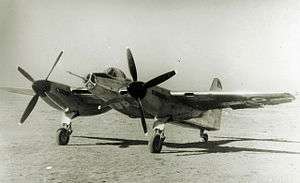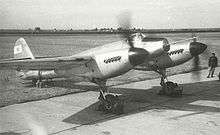I.Ae. 30 Ñancú
| I.Ae. 30 "Ñancú" | |
|---|---|
 | |
| The I.Ae. 30 prototype in 1948 | |
| Role | Fighter |
| Manufacturer | Fabrica Militar de Aviones (FMA) |
| Designer | Cesare Pallavicino |
| First flight | 17 July 1948 |
| Retired | 1948 |
| Status | Cancelled |
| Primary user | the Fuerza Aérea Argentina (intended) |
| Number built | 1 prototype completed (2 others unfinished) |
|
| |
The I.Ae. 30 "Ñancú" was an Argentine twin piston engined fighter designed by the Instituto Aerotécnico (AeroTechnical Institute) in the late 1940s, similar to the de Havilland Hornet,[1] but made of metal rather than wood. Only one prototype was completed; the project was abandoned in favour of a jet aircraft.
Design and development
The I.Ae. 30 "Ñancú", named after an indigenous eagle of Patagonia, was designed by Italian engineer Cesare Pallavicino, who had come to Argentina in 1946. Pallavicino led a team of Argentine technicians and engineers in developing the concept of a high-speed escort fighter, intended to be operated in conjunction with the Avro Lincoln bombers used in the Argentine Air Force.
The I.Ae. 30 had a metal structure, its powerplants consisted of two Rolls-Royce Merlin 604 engines, each developing 1,800 hp at 3,000 RPM, and four-bladed propellers. The armament would consist of six 20 mm Oerlikon automatic cannons mounted in the nose, although later plans called for 20 mm Hispano-Suiza cannons as well as a 250 kg bomb under the fuselage and two batteries of five 83 mm rockets fitted underneath the wings. Nevertheless, the prototypes were unarmed.[1]
By the end of 1947, a contract was received for the first of three projected prototypes. On 9 June 1948 the first prototype was ready for ground tests and on 17 July 1948, the I.Ae. 30 took to the air for the first time, piloted by Captain Edmundo Osvaldo Weiss.
Operational history

The test results proved that the aircraft possessed good flying characteristics as well as meeting performance specifications. During a cross country flight, from Córdoba to Buenos Aires, the Ñancú reached a level speed of 780 km/h, setting a new piston engined speed record in South America, an achievement that has not been surpassed. Although the prototype was achieving design goals, the Fuerza Aérea Argentina was already considering the jet I.Ae. 27 Pulqui I as their future fighter program.
With official interest diminishing, in early 1949, the sole flying prototype was badly damaged in a landing accident when test pilot Carlos Fermín Bergaglio misjudged a landing and crashed. Although the pilot was uninjured and the aircraft could have been repaired, the Fabrica Militar de Aviones made a decision to abandon the project with the wrecked prototype, as well as the two unfinished prototypes still at the factory being scrapped.
Variants

- I.Ae 30 Nancu
- Attack variant, three prototypes built, one tested and crashed, two incomplete airframes later scrapped after the program was cancelled.
- Project 1
- Jet modification of the IAe-30 Nancu, also designed by Pallavicino, was to be a heavy fighter in a class of the Gloster Meteor: single-seater, two Rolls-Royce Derwent engines each producing 3.500 lb static thrust. The variant was to have been armed with four Hispano-Suiza cannons. None built.
- Project 2
- Light bomber with two crew: the pilot and the navigator, seated in a glazed nose or behind the pilot (with a solid nose variant). Armament included four Hispano-Suiza cannon and two bombs of 900 or 1,000 kg each in an internal bomb bay. It could also carry twenty 75mm air-to-ground rockets. None built.
Specifications (I.Ae. 30)
General characteristics
- Crew: one
- Length: 11.52 m (37 ft 10 in)
- Wingspan: 15 m (49 ft 3 in)
- Height: 5.16 m (16 ft 11 in)
- Wing area: 35.32 m2 (380.2 sq ft)
- Empty weight: 6,208 kg (13,686 lb)
- Gross weight: 7,600 kg (16,755 lb)
- Powerplant: 2 × Rolls-Royce Merlin 604 V-12 liquid-cooled piston engines, 1,342 kW (1,800 hp) each
Performance
- Maximum speed: 740 km/h (460 mph; 400 kn)
- Cruising speed: 500 km/h (311 mph; 270 kn)
- Range: 2,700 km (1,678 mi; 1,458 nmi)
- Endurance: 5 hrs 25 min
- Service ceiling: 8,000 m (26,247 ft)
- Wing loading: 215 kg/m2 (44 lb/sq ft)
- Power/mass: 0.353 kW/kg (0.215 hp/lb)
Armament
- 6 × 20 mm cannons
- 1 × 250 kg bomb (under fuselage)
- 10 × rockets (under wings)
See also
- Aircraft of comparable role, configuration and era
References
- Notes
- 1 2 "Aviation 1806-1982." militariarg.com. Retrieved: 14 August 2010.
- Bibliography
- Aero Fan n. 61 (in Italian), April- June 1997.
- "Article online on the 75th Anniversary of the 'Fabrica Militar de Aviones'. (Spanish) aeroespacio.com, Buenos Aires: Aerospacio, 2002.
- Burzaco, Ricardo. Las Alas de Perón: Aeronaútica Argentina 1945/1960 (Spanish). New York: Ed. Da Vinci, 1995. ISBN 978-987-96764-4-8.
External links
![]() Media related to I.Ae. 30 Ñancú at Wikimedia Commons
Media related to I.Ae. 30 Ñancú at Wikimedia Commons